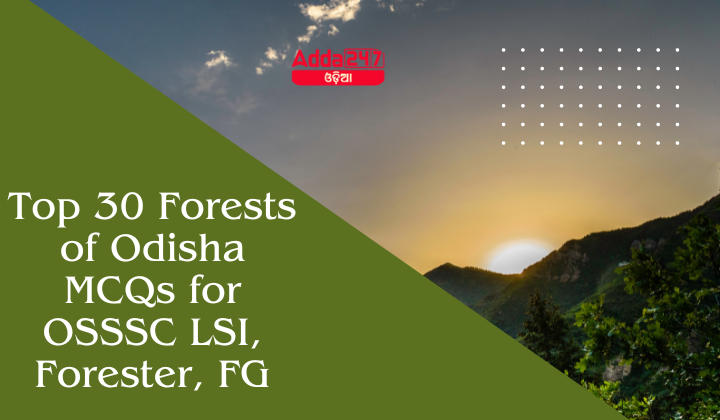Odisha, with its rich biodiversity, is home to numerous forests that play a crucial role in maintaining ecological balance and supporting various wildlife species. Aspirants preparing for Odisha Sub-ordinate Staff Selection Commission (OSSSC) exams for positions like Livestock Inspector (LSI), Forester, and Forest Guard (FG) need to have a thorough understanding of the forests in the state. This article presents a set of Multiple Choice Questions (MCQs) to help candidates test their knowledge about the top 30 forests of Odisha.
Top 30 Forests of Odisha MCQs for OSSSC LSI, Forester, FG
A strong grasp of the forests of Odisha is essential for aspirants preparing for OSSSC exams for positions like Livestock Inspector (LSI), Forester, and Forest Guard (FG). These MCQs provide a comprehensive review of the top 30 forests in Odisha, covering their location, unique features, and wildlife populations. Practicing these questions will help candidates assess their knowledge and prepare effectively for the exams.
- What is the recorded forest area of Odisha according to the India State of Forest Report, 2017?
a) 61,204.17 sq km
b) 39.31% of the state’s geographical area
c) Both a and b
d) None of the above
Answer: c) Both a and b - Which type of forest in Odisha is permanently marked for the production of timber or other forest produce, allowing grazing and cultivation?
a) Reserved Forest
b) Protected Forest
c) Unclassed Forest
d) None of the above
Answer: a) Reserved Forest - What percentage of Odisha’s total forest area is constituted by Reserved Forests according to the India State of Forest Report, 2017?
a) 58.90%
b) 40.75%
c) 0.35%
d) None of the above
Answer: a) 58.90% - Which type of forest in Odisha allows grazing and cultivation with minor restrictions?
a) Reserved Forest
b) Protected Forest
c) Unclassed Forest
d) None of the above
Answer: b) Protected Forest - What is the percentage of Odisha’s total forest area constituted by Unclassed Forests according to the India State of Forest Report, 2017?
a) 58.90%
b) 40.75%
c) 0.35%
d) None of the above
Answer: c) 0.35% - Which forest divisions in Odisha host the described forests?
A) Sundergarh, Balangir, Angul, Sambalpur, Keonjhar
B) Dhenkanal, Athgarh, Puri, Mayurbhanj, Nayagarh
C) Cuttack, Jajpur, Jagatsinghpur, Bhadrak, Kendrapara
D) Bargarh, Jharsuguda, Deogarh, Nuapada, Gajapati
Answer: B) Dhenkanal, Athgarh, Puri, Mayurbhanj, Nayagarh - What is the minimum elevation above which these forests are found?
A) 100 meters
B) 400 meters
C) 600 meters
D) 800 meters
Answer: C) 600 meters - Which of the following is a characteristic of the top storey trees in these forests?
A) Evergreen foliage
B) Absence of bamboo growth
C) Leafless for a short span
D) Tall and straight trunks
Answer: C) Leafless for a short span - What type of trees typically form the second storey in these forests?
A) Deciduous trees
B) Bamboo
C) Evergreen trees
D) Thorny shrubs
Answer: C) Evergreen trees - Which of the following tree species is NOT mentioned as important in these forests?
A) Mango
B) Arjun
C) Bamboo
D) Mankarkendu
Answer: C) Bamboo - What type of forests cover the smallest area in Odisha?
a) Tropical Rainforests
b) Deciduous Forests
c) Mangrove Forests
d) Coniferous Forests
Answer: c) Mangrove Forests - Which regions of Odisha are primarily home to mangrove forests?
a) Northern Plains
b) Western Ghats
c) Sea-Coast
d) Eastern Plateau
Answer: c) Sea-Coast - Which river’s delta hosts a significant portion of Odisha’s mangrove forests?
a) Ganges
b) Godavari
c) Mahanadi
d) Brahmaputra
Answer: c) Mahanadi - What is the maximum area covered by mangrove forests in Bhitarkanika?
a) 10,987 hectares
b) 12,987 hectares
c) 14,987 hectares
d) 16,987 hectares
Answer: c) 14,987 hectares - Which of the following is NOT a characteristic of mangrove plants?
a) Salt-tolerant
b) Found in freshwater only
c) Found in inter-tidal regions
d) Thrive in brackish water
Answer: b) Found in freshwater only - What purpose do mangrove forests serve in coastal areas?
a) Increase sea erosion
b) Provide habitat for urban development
c) Protect against cyclones and tidal surges
d) Accelerate tidal surge
Answer: c) Protect against cyclones and tidal surges - What is the nickname given to the tidal forests of the Mahanadi mouth?
a) Mini Sundarbans
b) Lesser Sundarbans
c) Little Sundarbans
d) Tiny Sundarbans
Answer: c) Little Sundarbans - Which species is predominant in Odisha’s mangrove forests?
a) Sundari
b) Karika
c) Bani
d) Hental
Answer: d) Hental - What is the significance of Iron wood plantation in Puri coast?
a) Provides habitat for wildlife
b) Serves as a tourist attraction
c) Provides fuel to the people
d) Prevents sea erosion
Answer: c) Provides fuel to the people - What feature separates mangrove forests from the cultivated zone in Odisha?
a) Desert
b) Grassland
c) Wetland
d) Mountain range
Answer: b) Grassland - When was the Odisha Forest Development Corporation Limited (OFDC) established?
A) 1962
B) 1979
C) 1990
D) 1985
Answer: C) 1990 - What are the objectives of OFDC?
A) To exploit forest resources unfairly
B) To provide unfair wages to forest laborers
C) To promote forest-based industries in the state
D) None of the above
Answer: C) To promote forest-based industries in the state - When did the Odisha State Forest Department come into existence?
A) 1883-84
B) 1912
C) 1936
D) 1983
Answer: C) 1936 - What was the Odisha Forest Department initially a part of?
A) Bengal
B) Bihar
C) Madhya Pradesh
D) Uttar Pradesh
Answer: A) Bengal - Which divisions were created within the Odisha Forest Division in 1912?
A) Angul and Puri
B) Angul and Sambalpur
C) Puri and Sambalpur
D) Cuttack and Berhampur
Answer: A) Angul and Puri - What are the primary objectives of the Odisha State Forest Department?
A) Exploitation of forest resources
B) Conserving natural heritage
C) Reducing sustainability
D) None of the above
Answer: B) Conserving natural heritage - Which policy guidelines does the Department of Forest and Environment Odisha follow?
A) National Forest Policy, 1990
B) Odisha Forest Sector Vision 2030
C) Joint Forest Management Resolution, 2001
D) National Forest Policy, 1988
Answer: D) National Forest Policy, 1988 - What is the aim of the Department of Forest and Environment Odisha?
A) Exploitation of forest resources
B) Regeneration and extension of forest and tree cover
C) Environmental degradation
D) All of the above
Answer: B) Regeneration and extension of forest and tree cover - Which corporation was NOT merged to form OFDC?
A) Odisha Forest Corporation
B) Simlipal Forest Development Corporation Limited
C) Odisha Composite Board
D) Bihar Plantation Development Corporation Limited
Answer: D) Bihar Plantation Development Corporation Limited - What does OFDC aim to provide to the government?
A) Insufficient revenue
B) Fair wages
C) Unscientific exploitation of forest resources
D) Sufficient revenue
Answer: D) Sufficient revenue














